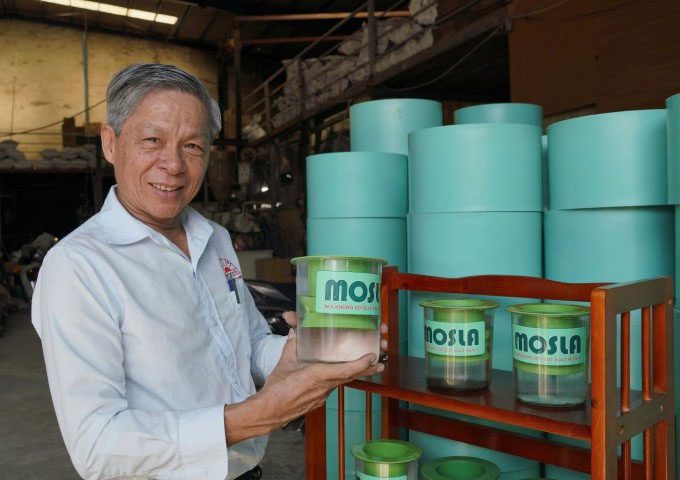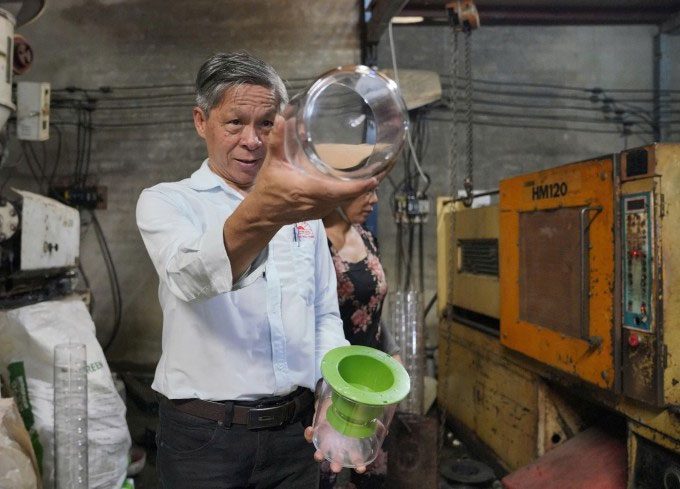Without using electricity or chemicals, Mr. Nguyen Van Khoe (residing in Bien Hoa City, Dong Nai) has created a trap to attract female mosquitoes to lay eggs and trap larvae in a plastic container.
Mr. Khoe, 60 years old, has only completed the 8th grade, but with a passion for invention, he has invested time and effort over more than two years to create a mosquito-catching device.
The idea originated in 2016 when he established a company providing solar heat drying solutions. While installing drying systems for clients, he noticed that mosquitoes were prevalent almost everywhere, especially during the rainy season. He observed that solutions using electric swatters, mosquito coils, or chemicals “are not entirely safe and can have side effects for people who are prone to allergies, such as the elderly and children,” he thought. In 2022, while cleaning a water fan, he discovered many mosquitoes flying out from the water reservoir. Upon disassembling the fan’s water container, he found numerous larvae swimming inside. “I thought about making a mosquito trap from this discovery,” Mr. Khoe said.

The mosquito trap invented by Mr. Nguyen Van Khoe. (Photo: Cong Khang).
Lacking specialized knowledge, Mr. Khoe researched mosquito biological behavior online. He realized that current solutions only kill adult mosquitoes and do not address their reproduction or population increase. Recognizing that mosquitoes breed in stagnant water and dark places, he designed the mosquito trap to prevent them from increasing in number by laying eggs.
He designed a cylindrical mosquito trap made from 3D-printed plastic. The product consists of two main components: a place for female mosquitoes to lay eggs and an area to collect larvae after they hatch. When users pour water into the trap, it attracts female mosquitoes to lay their eggs. The egg-laying area has a funnel structure with a gap at the bottom. Within 3 to 4 weeks, the eggs will hatch into larvae, which will then move through the gap into the collection area. With no food and unable to escape because this area is sealed, the larvae will die after a few days, and their remains will fall to the bottom of the container. When the trap accumulates debris at the bottom, users can clean it and refill it with water for continued use. “Mosquitoes prefer to lay eggs in clean water, so this product is very suitable for catching mosquitoes,” Mr. Khoe said.
During the manufacturing process, he mentioned that designing the gap for the larvae to move to the collection area was the most challenging part. The gap needed to be neither too small for the larvae to squeeze through nor too large that they could swim back to the egg-laying area. Over approximately six months, he experimented with various gap sizes to find the optimal width. He ordered 3D-printed plastic frames to save costs whenever he adjusted technical specifications. Practical tests showed that, after about three months, the device could catch 50 to 70 larvae and hundreds of eggs.
The structure and operation of Mr. Nguyen Van Khoe’s mosquito trap. (Video: Cong Khang).
The 60-year-old inventor stated that he plans to give the product to each household for 1 to 3 months for evaluation. When gifting the product, he will survey the locations and surrounding environments and advise on the best placement for the trap to achieve maximum effectiveness. He intends to sell the product at 100,000 VND to serve the community. “The government has often promoted that without larvae, there will be no dengue fever. My product can contribute to achieving this goal,” Mr. Khoe said. His mosquito trap received a utility solution patent from the Intellectual Property Office in early 2023.
Reflecting on dropping out after the 8th grade, he described it as “a somewhat impulsive decision.” At that time, he had good academic performance. During that school year, he fell ill and had to spend two weeks in the hospital. When he returned to school, he received a score of 2 from his teacher for not being able to complete the assignment. He felt so embarrassed and sad that he decided to quit school and venture into various business fields. “In life, I taught myself to survive and promised myself to learn even more to make up for the time I lost in school,” Mr. Khoe shared.
Mr. Nguyen Van Khanh, 40, from Binh Chanh District, evaluated the product priced at 100,000 VND as very affordable for the public. It can be cleaned and reused safely for people and the environment compared to traditional mosquito extermination methods.
Master Tran Phi Hung, a parasitologist and entomologist and former lecturer at the Biology and Biotechnology Department of the University of Science, Ho Chi Minh City, stated that the mosquito trap targets the species that transmits dengue fever to humans. Dengue mosquitoes are known to be active during the day and prefer to lay eggs in small containers in shaded and slightly dark areas, aligning with the author’s proposed solution.
However, Mr. Hung pointed out that in high-density areas, just one or two days can lead to numerous eggs being laid in containers that exhibit these characteristics, not just those with traps.
According to Mr. Hung, the author needs additional supportive solutions to attract mosquitoes to lay eggs in his trap. “There should be a comparison of the author’s mosquito-catching container with other containers to clearly demonstrate its effectiveness,” he suggested, noting that each mosquito species has different egg-laying behaviors. Some species lay eggs in stagnant water, slow-flowing water, or fast-flowing water. Some prefer to reproduce in clean water, while others lay eggs in dirty water or shaded areas… It depends on the characteristics of each species to determine the appropriate trapping method.

Mr. Khoe checks the product at a mechanical workshop. (Photo: Cong Khang).
The expert believes that in addition to this method, light traps can also be used to attract mosquitoes at night. Natural mosquito traps are generally safe; however, Master Hung notes that while chemical extermination is often considered the fastest and cheapest method for mosquitoes or harmful insects in general, using chemicals can have adverse effects on nature and humans, so it should be used in reasonable amounts.


















































